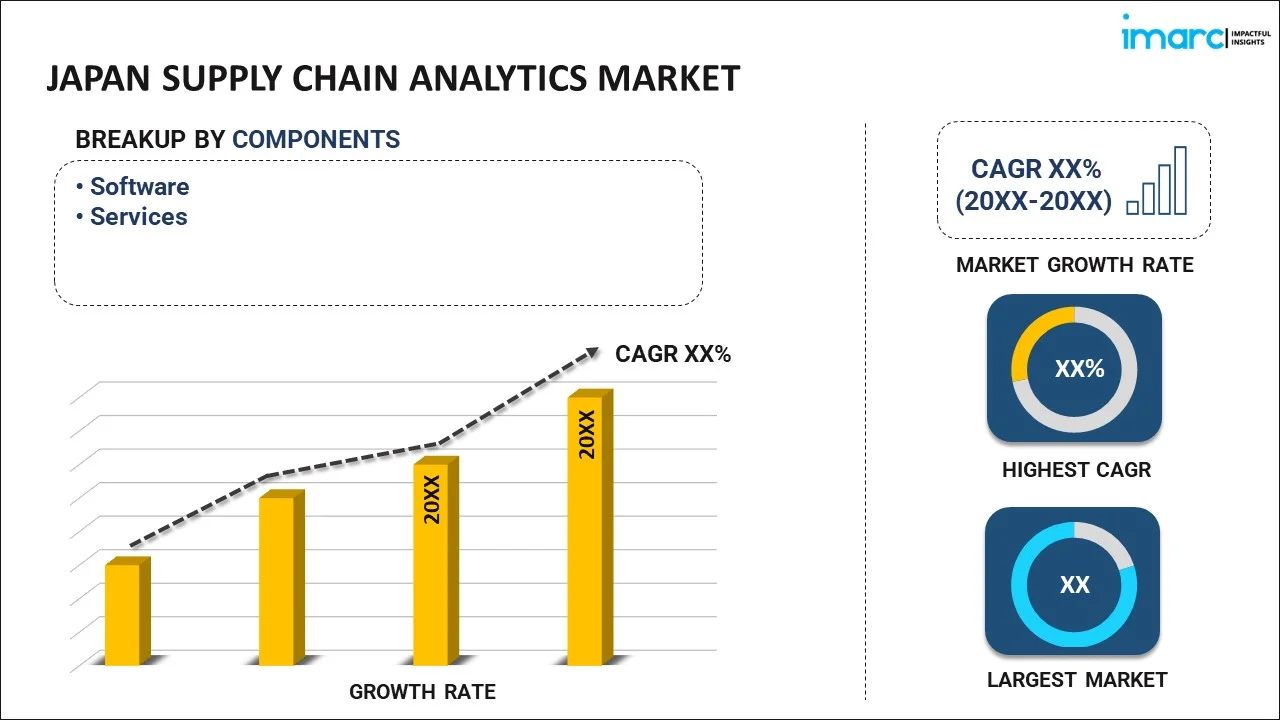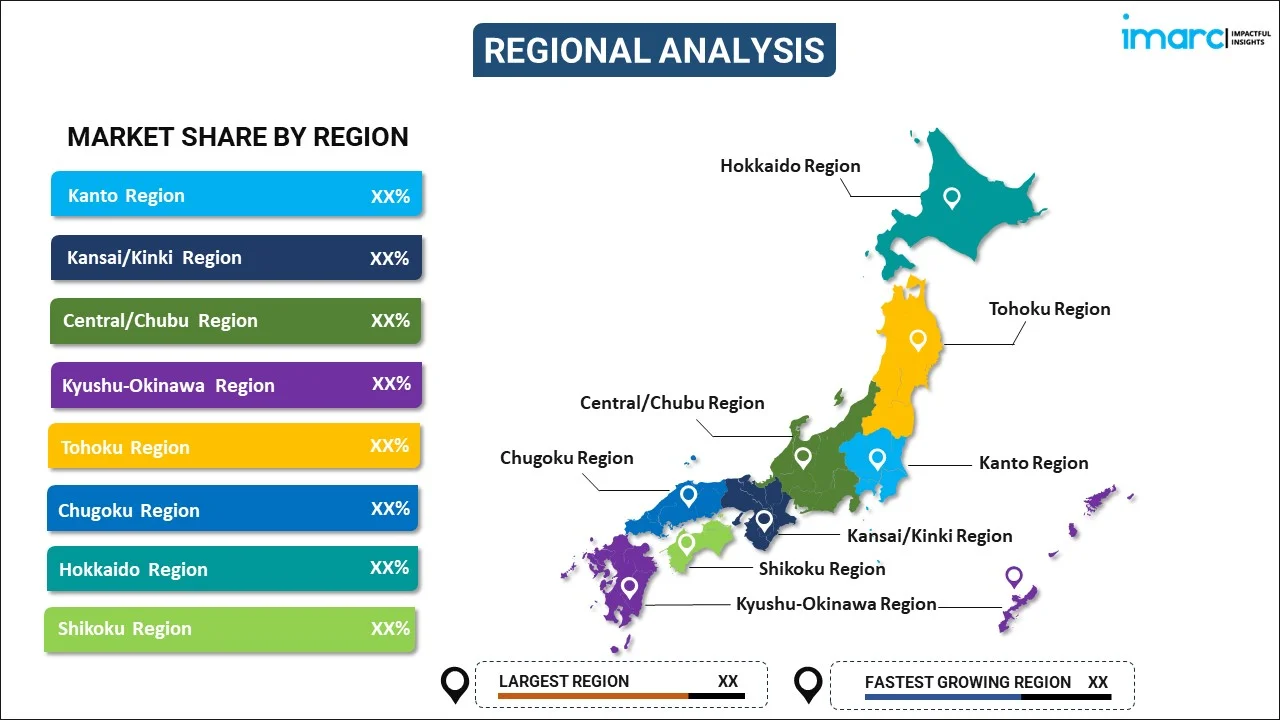
Japan Supply Chain Analytics Market Report by Component (Software, Services), Deployment Mode (On-premises, Cloud-based), Enterprise Size (Large Enterprises, Small and Medium Enterprises), Industry Vertical (Automotive, Food and Beverages, Healthcare and Pharmaceuticals, Manufacturing, Retail and Consumer Goods, Transportation and Logistics, and Others), and Region 2025-2033
Market Overview:
Japan supply chain analytics market size reached USD 491.6 Million in 2024. Looking forward, IMARC Group expects the market to reach USD 2,051.1 Million by 2033, exhibiting a growth rate (CAGR) of 15.6% during 2025-2033. The market is being driven by the increasing digitalization of businesses, a rising need for comprehensive visibility and transparency throughout supply chains, and the growing trend of online shopping where individuals purchase products and services from e-commerce platforms.
|
Report Attribute
|
Key Statistics
|
|---|---|
|
Base Year
|
2024 |
|
Forecast Years
|
2025-2033
|
|
Historical Years
|
2019-2024
|
| Market Size in 2024 | USD 491.6 Million |
| Market Forecast in 2033 | USD 2,051.1 Million |
| Market Growth Rate (2025-2033) | 15.6% |
Supply chain analytics involves gathering, analyzing, and interpreting data from diverse sources within a supply chain to extract actionable insights, enhance operations, and make well-informed choices. This approach integrates statistical methods, data analysis, predictive modeling, and business intelligence to convert raw data into valuable information, aiding organizations in optimizing their supply chain operations and meeting strategic goals. It enhances customer satisfaction and loyalty through reliable product availability and timely deliveries. Additionally, it empowers companies to gain a competitive advantage by swiftly adapting to market shifts and meeting evolving customer demands.
Japan Supply Chain Analytics Market Trends:
The supply chain analytics market in Japan is experiencing substantial growth driven by several key factors. Firstly, there is a growing recognition of the significance of data-driven decision-making in supply chain management. As businesses in Japan increasingly embrace digital transformation, they are leveraging supply chain analytics to gain deeper insights into their operations. Secondly, the demand for end-to-end visibility and transparency in supply chains is on the rise. Companies in Japan are keen to track every aspect of their supply chains, from sourcing raw materials to delivering finished products. This heightened focus on visibility is driven by the need to improve efficiency, reduce costs, and enhance customer satisfaction. Moreover, the e-commerce sector in Japan is booming, with a significant increase in online shopping activities. As consumers turn to e-commerce platforms for their purchasing needs, businesses are under pressure to meet the demands for fast and accurate deliveries. In addition to these factors, supply chain analytics is becoming a strategic imperative for Japanese businesses looking to remain competitive in a regional market. In conclusion, the Japan supply chain analytics market is witnessing robust growth due to the increasing recognition of data-driven decision-making, a rising demand for transparency, the surge in e-commerce activities, and the strategic importance of analytics in the business landscape. These trends are driving businesses in Japan to invest in supply chain analytics solutions to enhance their competitiveness and efficiency in an ever-evolving market.
Japan Supply Chain Analytics Market Segmentation:
IMARC Group provides an analysis of the key trends in each segment of the market, along with forecasts at the country level for 2025-2033. Our report has categorized the market based on component, deployment mode, enterprise size, and industry vertical.
Component Insights:

- Software
- Demand Analysis and Forecasting
- Supplier Performance Analytics
- Spend and Procurement Analytics
- Inventory Analytics
- Transportation and Logistics Analytics
- Services
- Professional
- Support and Maintenance
The report has provided a detailed breakup and analysis of the market based on the component. This includes software (demand analysis and forecasting, supplier performance analytics, spend and procurement analytics, inventory analytics, and transportation and logistics analytics) and services (professional and support and maintenance).
Deployment Mode Insights:
- On-premises
- Cloud-based
A detailed breakup and analysis of the market based on the deployment mode have also been provided in the report. This includes on-premises and cloud-based.
Enterprise Size Insights:
- Large Enterprises
- Small and Medium Enterprises
The report has provided a detailed breakup and analysis of the market based on the enterprise size. This includes large enterprises and small and medium enterprises.
Industry Vertical Insights:
- Automotive
- Food and Beverages
- Healthcare and Pharmaceuticals
- Manufacturing
- Retail and Consumer Goods
- Transportation and Logistics
- Others
A detailed breakup and analysis of the market based on the industry vertical have also been provided in the report. This includes automotive, food and beverages, healthcare and pharmaceuticals, manufacturing, retail and consumer goods, transportation and logistics, and others.
Regional Insights:

- Kanto Region
- Kansai/Kinki Region
- Central/ Chubu Region
- Kyushu-Okinawa Region
- Tohoku Region
- Chugoku Region
- Hokkaido Region
- Shikoku Region
The report has also provided a comprehensive analysis of all the major regional markets, which include Kanto Region, Kansai/Kinki Region, Central/ Chubu Region, Kyushu-Okinawa Region, Tohoku Region, Chugoku Region, Hokkaido Region, and Shikoku Region.
Competitive Landscape:
The market research report has also provided a comprehensive analysis of the competitive landscape in the market. Competitive analysis such as market structure, key player positioning, top winning strategies, competitive dashboard, and company evaluation quadrant has been covered in the report. Also, detailed profiles of all major companies have been provided.
Japan Supply Chain Analytics Market Report Coverage:
| Report Features | Details |
|---|---|
| Base Year of the Analysis | 2024 |
| Historical Period | 2019-2024 |
| Forecast Period | 2025-2033 |
| Units | Million USD |
| Scope of the Report | Exploration of Historical Trends and Market Outlook, Industry Catalysts and Challenges, Segment-Wise Historical and Future Market Assessment:
|
| Components Covered |
|
| Deployment Modes Covered | On-premises, Cloud-based |
| Enterprise Sizes Covered | Large Enterprises, Small and Medium Enterprises |
| Industry Verticals Covered | Automotive, Food and Beverages, Healthcare and Pharmaceuticals, Manufacturing, Retail and Consumer Goods, Transportation and Logistics, Others |
| Regions Covered | Kanto Region, Kansai/Kinki Region, Central/ Chubu Region, Kyushu-Okinawa Region, Tohoku Region, Chugoku Region, Hokkaido Region, Shikoku Region |
| Customization Scope | 10% Free Customization |
| Post-Sale Analyst Support | 10-12 Weeks |
| Delivery Format | PDF and Excel through Email (We can also provide the editable version of the report in PPT/Word format on special request) |
Key Questions Answered in This Report:
- How has the Japan supply chain analytics market performed so far and how will it perform in the coming years?
- What has been the impact of COVID-19 on the Japan supply chain analytics market?
- What is the breakup of the Japan supply chain analytics market on the basis of component?
- What is the breakup of the Japan supply chain analytics market on the basis of deployment mode?
- What is the breakup of the Japan supply chain analytics market on the basis of enterprise size?
- What is the breakup of the Japan supply chain analytics market on the basis of industry vertical?
- What are the various Components in the value chain of the Japan supply chain analytics market?
- What are the key driving factors and challenges in the Japan supply chain analytics?
- What is the structure of the Japan supply chain analytics market and who are the key players?
- What is the degree of competition in the Japan supply chain analytics market?
Key Benefits for Stakeholders:
- IMARC’s industry report offers a comprehensive quantitative analysis of various market segments, historical and current market trends, market forecasts, and dynamics of the Japan supply chain analytics market from 2019-2033.
- The research report provides the latest information on the market drivers, challenges, and opportunities in the Japan supply chain analytics market.
- Porter's five forces analysis assist stakeholders in assessing the impact of new entrants, competitive rivalry, supplier power, buyer power, and the threat of substitution. It helps stakeholders to analyze the level of competition within the Japan supply chain analytics industry and its attractiveness.
- Competitive landscape allows stakeholders to understand their competitive environment and provides an insight into the current positions of key players in the market.
Need more help?
- Speak to our experienced analysts for insights on the current market scenarios.
- Include additional segments and countries to customize the report as per your requirement.
- Gain an unparalleled competitive advantage in your domain by understanding how to utilize the report and positively impacting your operations and revenue.
- For further assistance, please connect with our analysts.
 Inquire Before Buying
Inquire Before Buying
 Speak to an Analyst
Speak to an Analyst
 Request Brochure
Request Brochure
 Request Customization
Request Customization




.webp)




.webp)












